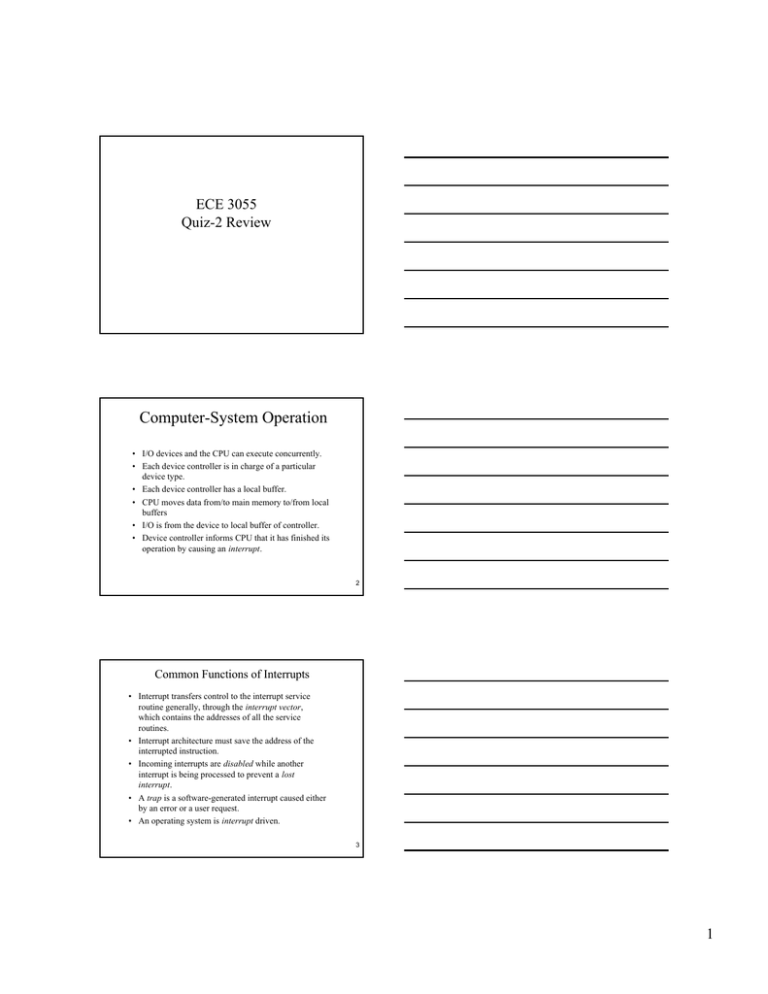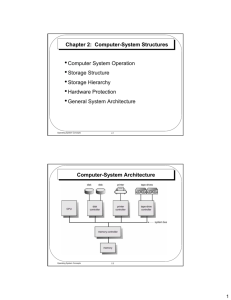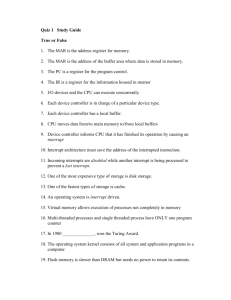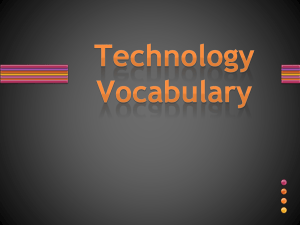Computer-System Operation ECE 3055 Quiz-2 Review
advertisement

ECE 3055 Quiz-2 Review Computer-System Operation • I/O devices and the CPU can execute concurrently. • Each device controller is in charge of a particular device type. • Each device controller has a local buffer. • CPU moves data from/to main memory to/from local buffers • I/O is from the device to local buffer of controller. • Device controller informs CPU that it has finished its operation by causing an interrupt. 2 Common Functions of Interrupts • Interrupt transfers control to the interrupt service routine generally, through the interrupt vector, which contains the addresses of all the service routines. • Interrupt architecture must save the address of the interrupted instruction. • Incoming interrupts are disabled while another interrupt is being processed to prevent a lost interrupt. • A trap is a software-generated interrupt caused either by an error or a user request. • An operating system is interrupt driven. 3 1 Interrupt Handling • The operating system preserves the state of the CPU by storing registers and the program counter. • Determines which type of interrupt has occurred: – polling – vectored interrupt system • Separate segments of code determine what action should be taken for each type of interrupt • “Trap” - a software driven interrupt 4 I/O Structure • Synchronous - After I/O starts, control returns to user program only upon I/O completion. – wait instruction idles the CPU until the next interrupt – wait loop (contention for memory access). – At most one I/O request is outstanding at a time, no simultaneous I/O processing (for a single “thread”) . • Asynchronous - After I/O starts, control returns to user program without waiting for I/O completion. – System call – request to the operating system to allow user to wait for I/O completion. – Device-status table contains entry for each I/O device indicating its type, address, and state. – Operating system indexes into I/O device table to determine device status and to modify table entry to include interrupt. 5 Dual-Mode Operation • Sharing system resources requires operating system to ensure that an incorrect program cannot cause other programs to execute incorrectly. • Provide hardware support to differentiate between at least two modes of operations. 1. User mode – execution done on behalf of a user. 2. Monitor mode (also supervisor mode or system mode) – execution done on behalf of operating system. Interrupt/fault monitor user set user mode 6 2 Process Management • A process is a program in execution. A process needs certain resources, including CPU time, memory, files, and I/O devices, to accomplish its task. • The operating system is responsible for the following activities in connection with process management. – Process creation and deletion. – process suspension and resumption. – Provision of mechanisms for: • process synchronization • process communication 7 Main-Memory Management • Memory is a large array of words or bytes, each with its own address. It is a repository of quickly accessible data shared by the CPU and I/O devices. • Main memory is a volatile storage device. It loses its contents in the case of system failure. • The operating system is responsible for the following activities in connections with memory management: – Keep track of which parts of memory are currently being used and by whom. – Decide which processes to load when memory space becomes available. – Allocate and deallocate memory space as needed. 8 Secondary-Storage Management • Since main memory (primary storage) is volatile and too small to accommodate all data and programs permanently, the computer system must provide secondary storage to back up main memory. • Most modern computer systems use disks as the principle on-line storage medium, for both programs and data. • The operating system is responsible for the following activities in connection with disk management: – Free space management – Storage allocation – Disk scheduling 9 3 I/O System Management •The I/O system consists of: – A buffer-caching system – A general device-driver interface – Drivers for specific hardware devices 10 Command-Interpreter System • Many commands are given to the operating system by control statements which deal with: – process creation and management – I/O handling – secondary-storage management – main-memory management – file-system access – protection – networking • The program that reads and interprets control statements is called variously: – control-card interpreter – command-line interpreter – shell (in UNIX) – GUI = Desktop + Window Manager Its function is to get and execute the next command statement. 11 Operating System Services • • • • • Program execution – system capability to load a program into memory and to run it. I/O operations – since user programs cannot execute I/O operations directly, the operating system ust provide some means to perform I/O. File-system manipulation – program capability to read, write, create, and delete files. Communications – exchange of information between processes executing either on the same computer or on different systems tied together by a network. Implemented via shared memory or message passing . Error detection – ensure correct computing by detecting errors in the CPU and memory hardware, in I/O devices, or in user programs. 12 4 System Calls • System calls provide the interface between a running program and the operating system. – Generally available as assembly-language instructions. – Languages defined to replace assembly language for systems programming allow system calls to be made directly (e.g., C. Bliss, PL/360) • Three general methods are used to pass parameters between a running program and the operating system. – Pass parameters in registers. – Store the parameters in a table in memory, and the table address is passed as a parameter in a register. – Push (store) the parameters onto the stack by the program, and pop off the stack by operating system. 13 System Programs • System programs provide a convenient environment for program development and execution. The can be divided into: – File manipulation – Status information – File modification – Programming language support – Program loading and execution – Communications – Application programs • Most users’ view of the operation system is defined by system programs, not the actual system calls. 14 UNIX System Structure (GUI, Mouse & Keyboard Controllers) 15 5 Virtual Machines • A virtual machine takes the layered approach to its logical conclusion. It treats hardware and the operating system kernel as though they were all hardware. • A virtual machine provides an interface identical to the underlying bare hardware. • The operating system creates the illusion of multiple processes, each executing on its own processor with its own (virtual) memory. 16 Process Concept • • • • An operating system executes a variety of programs: – Batch system – jobs – Time-shared systems – user programs or tasks Textbook uses the terms job and process almost interchangeably. Process – a program in execution; process execution must progress in sequential fashion. A process includes: • As a process executes, it changes state – program counter – new: The process is being created. – stack – running: Instructions are being – data section executed. – waiting: The process is waiting for some event to occur. – ready: The process is waiting to be assigned to a process. – terminated: The process has finished execution. 17 Process Control Block (PCB) 18 6 Context Switch • When CPU switches to another process, the system must save the state of the old process and load the saved state for the new process. • Context-switch time is overhead; the system does no useful work while switching (frequently the major bottleneck in modern systems) • Time dependent on hardware support. 19 Threads • A thread (or lightweight process) is a basic unit of CPU utilization; it consists of: – program counter – register set – stack space • A thread shares with its peer threads its: – code section – data section – operating-system resources collectively know as a task. • A traditional or heavyweight process is equal to a task with one thread 20 Threads • • • • • Responsiveness (Blocked and non-blocked) Resource Sharing Economy Utilization of Multi-Proc. Architectures User and Kernal-supported threads – Many-to-One – One-to-One – Many-to-Many 21 7 Module 9: Memory Management • • • • • • Logical versus Physical Address Space Swapping Contiguous Allocation Paging Segmentation Segmentation with Paging 22 Binding of Instructions and Data to Memory Address binding of instructions and data to memory addresses can happen at three different stages. • Compile time: If memory location known a priori, absolute code can be generated; must recompile code if starting location changes. Locations on Stack (address = offset from Stack Point). • Load time: Must generate relocatable code if memory location is not known at compile time. • Execution time: Binding delayed until run time if the process can be moved during its execution from one memory segment to another. Need hardware support for address maps (e.g., base and limit registers). 23 Logical vs. Physical Address Space • The concept of a logical address space that is bound to a separate physical address space is central to proper memory management. – Logical address – generated by the CPU; also referred to as virtual address. – Physical address – address seen by the memory unit. • Logical and physical addresses are the same in compile-time and load-time address-binding schemes; logical (virtual) and physical addresses differ in execution-time address-binding scheme. 24 8 Swapping • • • • • A process can be swapped temporarily out of memory to a backing store , and then brought back into memory for continued execution. Backing store – fast disk large enough to accommodate copies of all memory images for all users; must provide direct access to these memory images. Roll out, roll in – swapping variant used for priority-based scheduling algorithms; lower-priority process is swapped out so higher-priority process can be loaded and executed. Major part of swap time is transfer time; total transfer time is directly proportional to the amount of memory swapped. Modified versions of swapping are found on many systems, i.e., UNIX and Microsoft Windows. 25 Paging Example 26 Segmentation • Memory-management scheme that supports user view of memory. • A program is a collection of segments. A segment is a logical unit such as: main program, procedure, function, local variables, global variables, common block, stack, symbol table, arrays 27 9 Module 10: Virtual Memory • • • • • • • • • Background Demand Paging Performance of Demand Paging Page Replacement Page-Replacement Algorithms (Optimal, FIFO, LRU) Allocation of Frames Thrashing Other Considerations Demand Segmentation 28 • Virtual memory – separation of user logical memory from physical memory. – Only part of the program needs to be in memory for execution. – Logical address space can therefore be much larger than physical address space. – Need to allow pages to be swapped in and out. • Virtual memory can be implemented via: – Demand paging – Demand segmentation 29 Demand Paging • Bring a page into memory only when it is needed. – Less I/O needed – Less memory needed – Faster response – More users • Page is needed ⇒ reference to it – invalid reference ⇒ abort – not-in-memory ⇒ bring to memory 30 10 Page Fault • If there is ever a reference to a page, first reference will trap to OS ⇒ page fault • OS looks at another table to decide: – Invalid reference ⇒ abort. – Just not in memory. • Get empty frame. • Swap page into frame. • Reset tables, validation bit = 1. • Restart instruction: Least Recently Used – block move 31 Demand Paging Example • Memory access time = 1 microsecond • 50% of the time the page that is being replaced has been modified and therefore needs to be swapped out. • Swap Page Time = 10 msec = 10,000 usec EAT = (1 – p) x 1us + p (15000us) 1 + 15000 P (in usec) Obviously we would like P to be much less than 1 If P = 0.0001, then EAT = 1 + 1.5 = 2.5 usec 32 Module 11: File-System Interface • • • • File Concept Access Methods Directory Structure Protection • • • • • • File-System Structure Allocation Methods Free-Space Management Directory Implementation Efficiency and Performance Recovery 33 11 File Attributes • Name – only information kept in human-readable form. • Type – needed for systems that support different types. • Location – pointer to file location on device. • Size – current file size. • Protection – controls who can do reading, writing, executing. • Time, date, and user identification – data for protection, security, and usage monitoring. • Information about files are kept in the directory structure, which is maintained on the disk. 34 File Operations • • • • • • • create write read reposition within file – file seek delete truncate open(Fi) – search the directory structure on disk for entry Fi, and move the content of entry to memory. • close (Fi) – move the content of entry Fi in memory to directory structure on disk. 35 Two-Level Directory • Separate directory for each user. • • • • Path name Can have the same file name for different user Efficient searching No grouping capability 36 12 Acyclic-Graph Directories • Have shared subdirectories and files (no circle paths versus a “General-Graph Directory) 37 Various Disk-Caching Locations 38 Module 12: I/O Systems • • • • I/O hardware Application I/O Interface Kernel I/O Subsystem Transforming I/O Requests to Hardware Operations • Performance 39 13 Interrupts • • • • CPU Interrupt request line triggered by I/O device Interrupt handler receives interrupts Maskable to ignore or delay some interrupts Interrupt vector to dispatch interrupt to correct handler – Based on priority – Some unmaskable • Interrupt mechanism also used for exceptions 40 • • • • • I/O system calls encapsulate device behaviors in generic classes Device-driver layer hides differences among I/O controllers from kernel Devices vary in many dimensions – Character-stream or block – Sequential or random-access – Sharable or dedicated – Speed of operation – read-write, read only, or write only Block devices include disk drives – Commands include read, write, seek – Raw I/O or file-system access – Memory-mapped file access possible Character devices include keyboards, mice, serial ports – Commands include get, put – Libraries layered on top allow line editing 41 Improving Performance • Reduce number of context switches, page faults • Reduce data copying • Reduce interrupts by using large transfers, smart controllers, polling • Use DMA • Balance CPU, memory, bus, and I/O performance for highest throughput 42 14 Module 13: Secondary-Storage • • • • • • • • • Disk Structure Disk Scheduling Disk Management Swap-Space Management Disk Reliability Stable-Storage Implementation Tertiary Storage Devices Operating System Issues Performance Issues 43 Disk Scheduling • • • • • • The operating system is responsible for using hardware efficiently — for the disk drives, this means having a fast access time and disk bandwidth. Access time has two major components – Seek time is the time for the disk are to move the heads to the cylinder containing the desired sector. – Rotational latency is the additional time waiting for the disk to rotate the desired sector to the disk head. – - 7200 rpm / 60 - 120 rps -> 8 ms per rotation Minimize seek time Seek time ≈ seek distance Disk bandwidth is the total number of bytes transferred, divided by the total time between the first request for service and the completion of the last transfer. Access algorithms: FCFS (FIFO), SSTF, SCAN, C-SCAN, LOOK, C-LOOK) 44 Swap-Space Management • • • • • Swap-space — Virtual memory uses disk space as an extension of main memory. Swap-space can be carved out of the normal file system,or, more commonly, it can be in a separate disk partition. Swap-space management – 4.3BSD allocates swap space when process starts; holds text segment (the program) and data segment. – Kernel uses swap maps to track swap-space use. – Solaris 2 allocates swap space only when a page is forced out of physical memory, not when the virtual memory page is first created. Disk striping uses a group of disks as one storage unit. RAID schemes improve performance and improve the reliability of the storage system by storing redundant data. – Mirroring or shadowing keeps duplicate of each disk. – Block interleaved parity uses much less redundancy. 45 15








